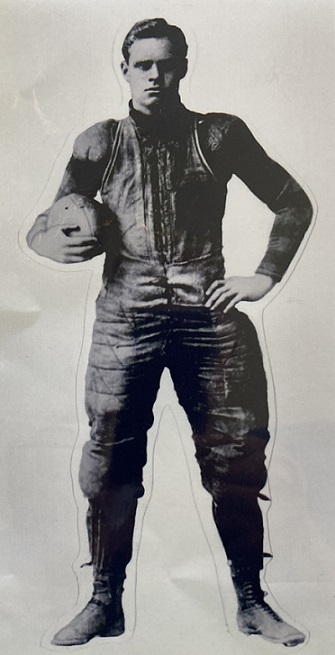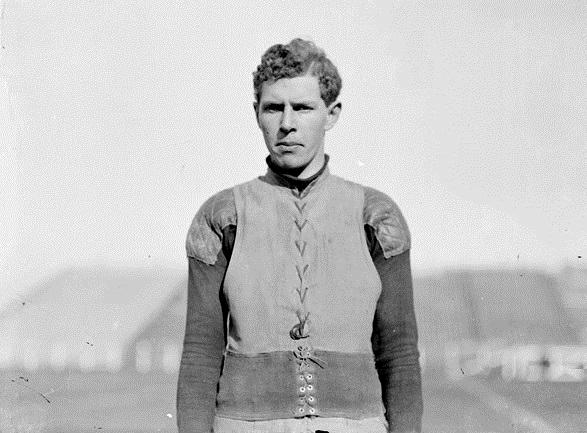Truxton Hare
Football
4-time All-American; 2-time Olympic medalist
 |
You have to wonder if, when midwestern advertising executive Samuel Gale was devising the characteristics of the fictional hero he created for his “Jack Armstrong, The All-American Boy” radio show, he had Truxton Hare in mind.
Armstrong, a popular radio staple from 1933 to 1951, was almost too good to be true. The big man on Hudson High’s campus was smart, good-looking, well-rounded, popular, and above all athletic.
In other words, he was the mirror image of Truxton Hare.
Born to a prominent Philadelphia family in 1878, Hare was movie-star handsome: Six feet tall, broad-shouldered, nearly 200 pounds, with wavy blond hair and a square jaw. He went to prep school in Massachusetts and was then an outstanding student at Penn, where he was president of his freshman class, performed in musicals and dramas, and led numerous student clubs.
As a senior in 1901, Hare was named Penn’s “Spoon Man,” an honor bestowed annually on the graduating class’ most popular student. He would go to law school, graduate in 1903, and have a successful and prosperous career as a corporate attorney in his hometown. Later in life, he took up archery and became one of the nation’s best archers as well as president of the Bowmen of America. He painted, shot skeet, wrote poetry, authored eight books for young adults, and was managing director and president of Bryn Mawr Hospital.
But it was at athletics where Hare excelled. In addition to playing cricket at Penn, he was also a superstar in both track-and-field and football. In the former, he threw the hammer, discus, and shot-put, broad-jumped, high-jumped, and ran the 100-yard dash and 120- and 220-yard hurdles. He was timed at 10.3 seconds in the 100 and broad-jumped 22 feet.
A member of the 1900 and 1904 US Olympic teams, Hare won a silver medal in the hammer throw in his first Games, and earned a bronze in the all-around (an event similar to today’s decathlon) at his second.
It was in the relatively new game of football, however, where the native Philadelphian gilded his Golden Boy reputation. Hare was one of sport’s earliest and brightest stars. A two-time captain at Penn, he led coach George Woodruff’s Quakers to a combined record of 47-5-2. He was one of only three players ever named a Walter Camp All-American for four consecutive years. According to Camp, Hare “could probably have been an All-American at any position.” In 1951, when the College Football Hall of Fame opened in its initial location of New Brunswick, NJ, he was one of its charter inductees.
Playing helmetless and combining athleticism, power, and savvy in a manner that mesmerized both fans and the era’s sportswriters, Hare was a guard-back (at the time guards were eligible to carry the ball). He not only ran and blocked for the Quakers, but he also kicked off, punted, called the signals, and drop-kicked extra points.
New York Sun sportswriter George Trevor once called Hare “a human juggernaut, whose inordinately powerful legs carried him ahead like the driving rods of a locomotive.” Another sportswriter said he “couldn’t be stopped.”
As a freshman, Hare led the Quakers to a 15-0 record. They averaged 30 points a game, allowed just 1.3 per game, and were selected national champions. Maybe more astonishingly, Hare played every minute of every game that season–and for the next three–an accomplishment that in later life led him to bemoan the stamina of contemporary footballers.
“A varsity player today is lucky if he gets in for half of the season’s playing time,” Hare noted in 1938. “Twenty to 30 minutes is a good average. In my day, we were broken-hearted if we didn’t play a full game, often twice a week.”
The Heisman Trophy wasn’t awarded until 1935, but when a panel of football experts gathered to select the players it believed would have won them in earlier years, Hare was named the would-be recipient for 1900.
Hare, who died at 77 in 1956, was also active in various charities and civic organizations and famously became an outspoken champion of Philadelphia. In 1932, when novelist Joseph Hergesheimer, who lived in Chester County, lambasted the city as a dull and parochial place, Hare publicly fought back.
Asked about this confrontation years later, Hare said, “Philadelphia might seem an unpleasant place to a stranger. But once he is taken in, he finds Philadelphia is a more warm-hearted place than most cities.”
By Frank Fitzpatrick
 |